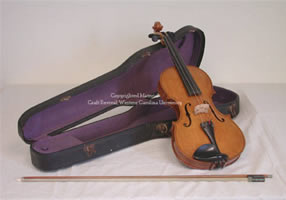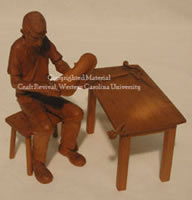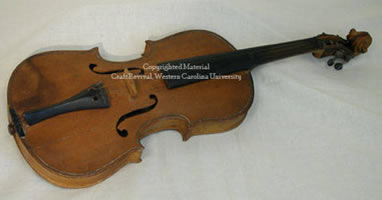Instruments:
Fiddle
“Fiddle making has been passed over as an art. It’s a real art, like painting or drawing…You can see it and you can hear it in the music.” - Ernie Hodges, Instrument Maker and Musician
The fiddling tradition of the southeastern Appalachians has a long and rich history, reaching back to the early settlement of the area. Through the years, fiddling in the mountains of this region emerged as a style of its own, influenced by many people and areas including the Scottish and Irish (with whom the Appalachians are so often affiliated), slaves of African descent, Italians, and others. In the fiddle makers of the mountains of North Carolina, Tennessee, Virginia, and Kentucky one can see the fallacy of the notion that the southern Appalachian region was an isolated rural backwater untouched by outside influence.
Whether called the fiddle or violin, the instrument in question is no different in construction. The distinction is found solely in conceptions of the style of play and the player. 1 This was true in the past and remains as an often heard question in the present. For some, “fiddle” refers to a folk or working class connotation, while “violin” is more indicative of a classical European style of playing. But for many others, these two terms were used interchangeably in reference to what was sometimes known as the “devil’s box.” 2
The mountains of the southeastern United States were settled at a time when the violin established itself as the popular instrument of the lower class in Europe. Long a favorite of the courts and other wealthy Europeans, increased production in the late seventeenth and early eighteenth century, and the mass printing of sheet music, allowed for a greater accessibility to violins among the lower classes. 3 This popularity in Europe was further pronounced in America-- in the pioneer settlements of the Appalachians and the West in particular--due to the small size of the instrument and the ease with which it could be transported.
Initially, solo playing was the dominant style of performance, but the pairing of fiddle and banjo quickly caught on for the performance of dance music in the late nineteenth century and rose in popularity through the first decades of the twentieth century. 4 It is interesting to compare the cross-cultural transmission of these two instruments. The banjo’s introduction to America came from Africa through slave communities while the fiddle was brought by European immigrants. 5 For both instruments music transcended racial and social boundaries. Both blacks and whites took up these two instruments in great numbers and the result was an instrumental pairing whose popularity is still prevalent in today’s bluegrass and country music.
Most of the fiddles played in the period of the Craft Revival were store-bought models produced by European and American manufacturers. These were available through local stores as well as through catalogs like Sears Roebuck or Montgomery Ward. 6 Like their classical-style contemporaries, though, string band musicians most cherished the hand-made work of the European master luthiers like Stainer and Stradivarius. Many a contest fiddler would claim to be playing an instrument produced by one of the Italian master makers. 7 Odd S. White, a Craft Revival period violin maker from Asheville, North Carolina, learned construction techniques from two men whom he credited with taking a scientific approach. These two individuals researched and passed on to Odd measurements, data, outlines, writings, history, and mathematical arrangements “showing where the Strad is beyond compare.” 8
Craft Revival makers evidenced a solid tradition of domestic fiddle production that resulted in many fine examples of the skill of American woodworkers. Utilizing many of the tools common to a woodworking shop--like planes, chisels, gauges, rasps, files, handsaws, and pocketknives--makers would fashion their works from molds and models. 9 Renowned woodcarver Wade Hampton Martin recalled memories of his father making fiddles in his time after work at the Beacon Manufacturing facility in Swannanoa, North Carolina during the Great Depression. Using his pocket knife, Marcus Martin carved the scrolls and bridges for the fiddles that he made both to play and to sell. 10 These craftsmen utilized many of the same techniques as the European master makers while also exploring a variety of different methods, in attempts to capture the unique sound desired for string band music. They experimented with different types of woods, varnishes, and tunings to alter the tone. In an attempt to gain a louder sound, American makers experimented with the utilization of metal strings and variations of the shaping of the instrument (for example using a higher arch and belly design). 11
For all of these variations, however, much of the process followed by makers in the mountains of the southeast was similar to those of European craftsmen. First, the wood had to be selected and cut into planks. In the southern Appalachians curly maple was most often used for the back, sides, and neck of a fiddle. Spruce was typically used for the top. The sound post was most often made of pine with other parts such as pegs, tail pieces, pins and others coming from the aforementioned woods or others such as dogwood, apple, or cherry. 12 Ernie Hodges was a contest winning fiddler as well as a fiddle maker, born in the mountains of North Carolina in 1907 and raised just south of Lexington, Kentucky. He emphasized that the selected material must “be wood that has a voice, a musical tone of its own.” 13 Next, the wood was cut to shape, often using the designs of manufactured fiddles as models and for the creation of molds. Of critical importance was carving the wood for the back and belly to the proper thickness. This was done using planes, files, and rasps. The thickness of the wood coupled with the positioning of the sound post determined the thinness or coarseness of the instrument. 14 In Mr. Hodges terms, “if the wood is too thick, the fiddle will sound thin and squeaky. If you whittle it too thin, the tone will be hard and coarse, have these overtones, what we call wolftones.” 15 These two factors required a high level of craftsmanship in properly gauging the tone of the instrument, a fact not lost on Craft Revival makers. Once the component parts were prepared, the fiddle was assembled using glue and wood screws and finished with a varnish to preserve the wood and its tone. 16
- Patrick Velde
See More: Fiddles
1. Charles Wolfe, The Devil’s Box: Masters of Southern Fiddling (Nashville, TN: Vanderbilt University Press, 1997), xvii.
2. Joe Wilson, The Blue Ridge Music Center: A Place Near the Heart (Silver Spring, MD: National Council for the Traditional Arts, 2000), 16.
3. Alan Jabbour, “The Fiddle in the Blue Ridge,” Blue Ridge Folk Instruments and Their Makers (Ferrum, VA: Blue Ridge Institute, 1993), 28.
4. Karen Linn, That Half Barbaric Twang (Chicago: University of Illinois Press, 1991), 118.
5. Ibid., 31.
6. Ibid., 31.
7. Wolfe, xvii.
8. Edward Dupuy, Artisans of the Appalachians (Asheville, NC: Miller Printin, 1967), 67.
9. Eliot Wigginton (Ed.), Foxfire 4 (Garden City, NY: Anchor Press, 1977), 116 and Ed Heron-Allen, Violin Making As it Was and Is (London: Ward Lock, 1885), 219.
10. Maggie Palmer Lauterer, “The Carvings of Wade Hampton Martin,” May We All Remember Well: A Journal of the History and Cultures of Western North Carolina Vol. I (Ed.) Robert S. Brunk (Asheville, NC: Robert S. Brunk Auction Services, 1997), 100.
11. Wolfe, xvii.
12. John Rice Irwin, Musical Instruments of the Southern Appalachians (Exton, PA: Schiffer, 1983), 14, Wigginton, 116, Wolfe, 216.
13. Ernie Hodges as quoted in Wolfe, 216.
14. Heron-Allen, 142.
15. Wolfe, 216.
16. Heron-Allen., 176.






